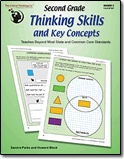Second Grade Thinking Skills & Key Concepts
Teaches Beyond Most State & Common Core Standards!
Grade: 2
Critical Thinking
Full curriculum
Grade: 2
Critical Thinking
Full curriculum
Components Sold Separately
Second Grade Thinking Skills & Key Concepts: Teacher's Manual
Description and Features
This highly-effective, standards-based, 160-page book is a research-based instructional program that teaches beyond most state and Common Core standards by:
- Improving children's observation and description skills
- Developing academic vocabulary
- Developing thinking skills that underlie content learning (describing/defining, identifying similarities and differences, sequencing, and classifying)
- Improving students' understanding of key concepts in mathematics, social studies, and science
- Students completing structured exercises to write sentences and paragraphs
- Carefully sequencing lessons to develop thinking skills
- Employing language integration techniques to teach thinking skills and key concepts
Academic Vocabulary Development
The program builds academic vocabulary using these important concepts: describe, compare and contrast, and classify shapes, position, patterns, matter, water, weather, land forms, bodies of water living and non-living things, communities, our country.
Observation Skills
Observation lessons involve concrete examples using detailed photographs to develop observation skills. The student book provides activities that students may use to clarify their thinking and learning by peer and class discussion.
Spatial Thinking Skills
• Describing Shapes – naming shapes, finding shapes to match a description, describing characteristics of a shape
• Similarities and Differences – matching and combining shapes, producing equal figures, figure completion
• Sequences – recognizing and producing the next figure in a sequence
• Classification – classifying by shape and/or color, forming classes, depicting overlapping classes
• Using positional and directional words
Verbal Thinking Skills
• Describing – matching a picture to a description, describing people, animals, or objects shown in pictures, part/whole analysis
• Similarities and Differences – selecting similar people, animals, or objects, explaining similarities and differences
• Sequences – ranking objects or people by a significant characteristic
• Classifications – explaining characteristics of a class, exceptions, sorting into classes
• Analogies – naming the kind of analogy or completing the analogy
Mental Models
This book teaches the characteristics outlined in its mental models needed to describe or define a concept.
How We Know It Works
• Increased scores on language proficiency and cognitive abilities tests
• Increased scores on normed or criterion-referenced achievement tests
• Proficient student writing
• Increased number of students placed in advanced classes and subsequent successful performance
Teaching Support
This student book can be used with a free, downloadable, answer PDF (get it here) or with a detailed, 192-page Teacher's Manual which can be purchased separately. The Teacher's Manual provides instructions to teach the lessons using research-proven methods that promote students' thinking: direct instruction, cooperative learning, whole sentence responding, and language integration activities. The Teacher's Manual physical book is in black and white, but the eBook version is in color.
Watch a short presentation on this highly effective product. View Online | PowerPoint | PDF





 View Sample Pages
View Sample Pages
